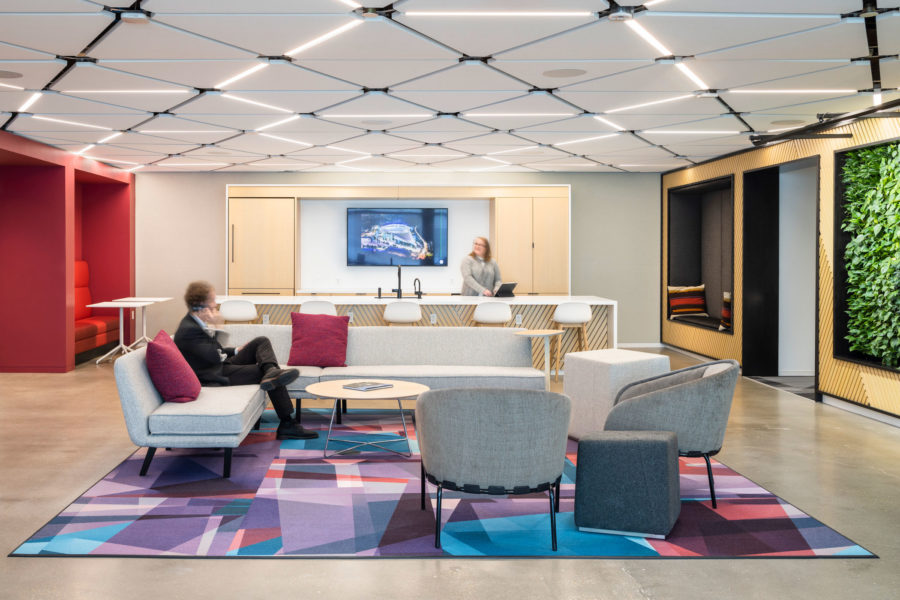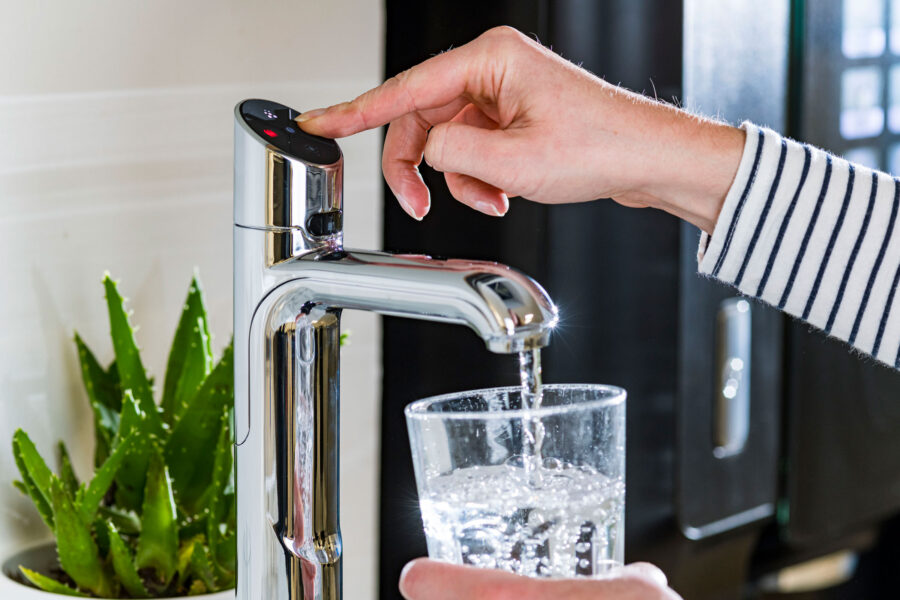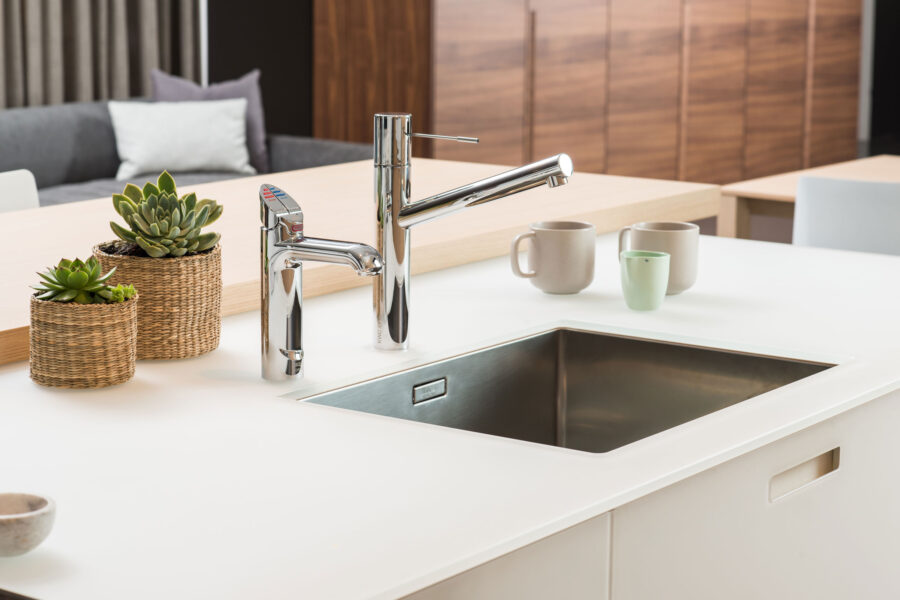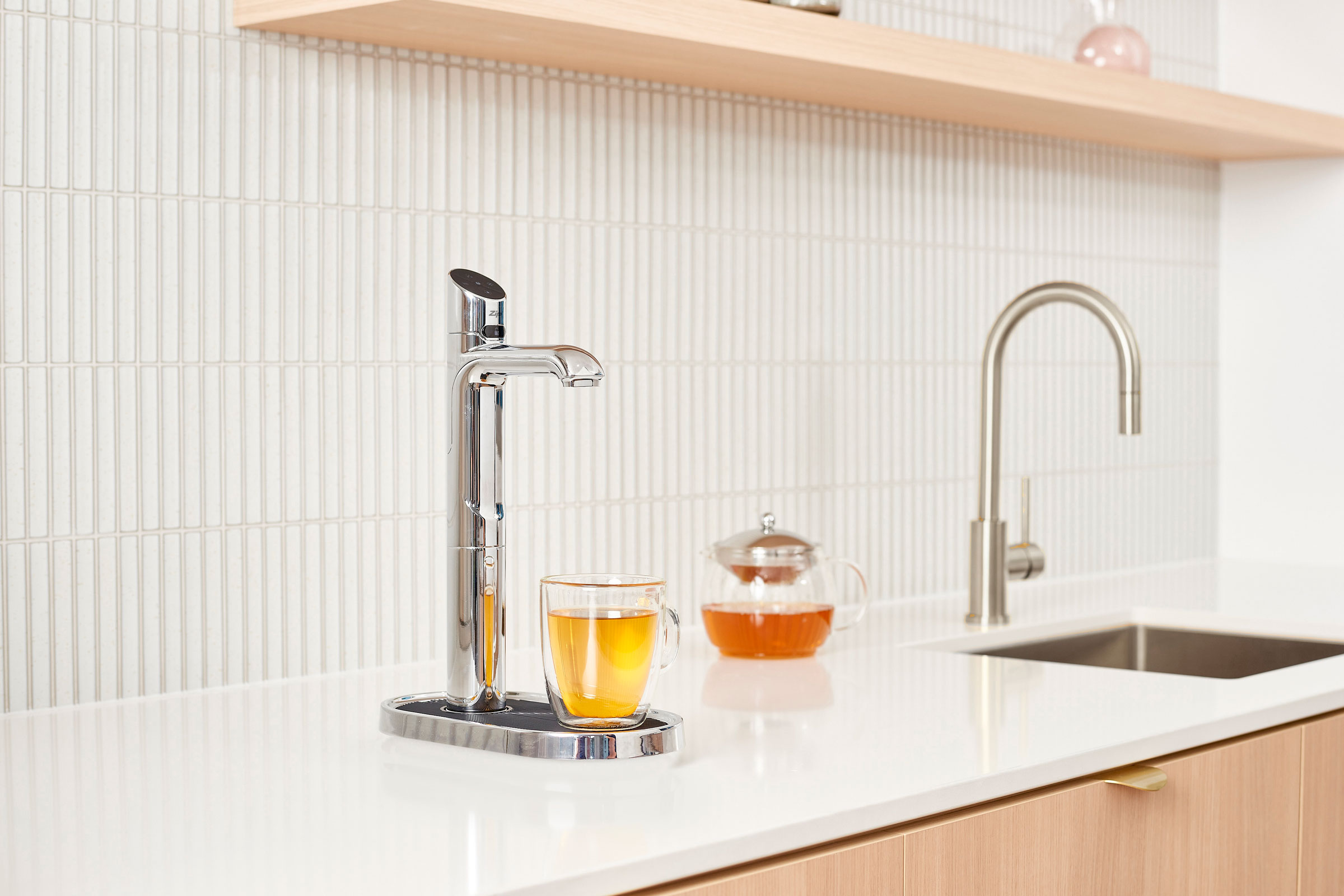Story at a glance
- The traditional office space is poised for change—from the way we work to the water we drink.
- Drinking more water offers a range of benefits—including better concentration and less fatigue.
- Flexible workspaces are increasingly in demand in the modern workplace, too.
Picture an office. Do you see dark gray cubicles and beige paint? Hear the glug of a watercooler and feel the rush of stale, dry air? If this kind of space makes you drained, even ill, you’re not alone. As early as 1991 the EPA had coined a term for the phenomenon where occupants of certain buildings were continuously unwell: sick building syndrome. Since then research has continued to show just how much our office lives impact our health and productivity. And the pandemic only sped up this inevitable scrutiny.
Today, as return-to-work requests (and mandates) begin circulating, workers are finally feeling empowered—especially the rising generation—to demand healthier, modern, flexible offices in which to spend their 40-hour weeks (90,000 over the course of a typical career). Designers, as well as innovative businesses, are responding with new methods, products, and services.
“The pandemic has caused the most disruption to office design in the history of the contemporary offices we see today,” says Liz Fallon, studio practice leader of commercial interiors at HKS—an international and interdisciplinary design firm. Fallon works closely with researchers and advisors at HKS to apply the latest science and social data to transform workplace design for clients across the world. “There are three main themes coming out of the pandemic as far as how organizations are using the office—so it is productive both for employees and for businesses,” she says.
Well-Being

The Walter P. Moore project designed by HKS earned LEED v4.1 Commercial Interiors LEED Gold certification. Photo courtesy of HKS
The first and arguably most researched theme, Fallon says, is using the office as a tool to increase employee health and well-being rather than drain it. “The bar has been raised. You have to be healthier when you leave your office than when you came in,” she says.
Before 2020 many offices were still relying on the same outdated and unhealthy equipment, materials, and practices. Harsh cleaning agents, aging HVAC, inadequate lighting, dull design, and little opportunity to maintain mental or physical health while working were commonplace.
Coming to the office has to be better for you than staying home.
But employees called back to the office today are demanding better. “Gen Z entered the workforce during the pandemic,” Fallon says. “It’s really added to the shift in priorities of the workplace. It has to go beyond luring people in with the amenities or incentives. Coming to the office has to be better for you than staying home.”
What would make the modern office healthier than staying home? HKS set out to answer that question in their own Chicago workspace starting in 2017, creating a living laboratory to test their theories. To promote health and well-being HKS designers used biophilic design strategies to bring the rich Midwestern landscapes inside—graphics of Lake Michigan at dawn, an Illinois wheat field washed in midday sun.
Lighting incorporated high-efficiency LED circadian design, leading to better employee sleep, while acoustic treatments cut down on overwhelm and distraction while working. An assortment of employee-chosen plants brought nature indoors and added whimsy as well as beauty. All this led to an incredible, and measurable, level of increased employee satisfaction and well-being. But Fallon cautions, the basics—air and water—are just as important as the look and feel in healthy modern office design.
“State-of-the-art air filtration and water filtration have become baseline requirements, especially in a post-pandemic world and workforce.” To address this the HKS design team retrofitted the HVAC system in their 1907 building to use displacement ventilation. The result: “The air here is cleaner than most of our homes,” Fallon says.
They also outfitted the office with sensors and monitors for things like CO2 and temperature to maintain the highest levels of health and comfort (no more fights over the thermostat or turning on the space heaters in summer). Replacing the big blue water cooler and dusty stacks of sparkling beverages, once staples in the office pantry, was another priority.

The Zip Water HydroTap is seen here in chrome. Photo courtesy of Zip Water
Maria Papadopoulos, product and portfolio manager at Zip Water, part of Culligan International Company, has been working to bring such high-tech hydration systems (like those used at HKS’s Chicago office) to the US market over the last four years. They’re already indispensable in Australian offices. Soon, she says, this technology will be a given around the world.
One product in particular, the HydroTap, is set to revolutionize communal hydration—offering a choice of highly filtered, chilled, boiling, and sparkling water all from a single, stylish tap. “Our filtration [a built-in 0.2-micron filter that meets NSF standards] is certified to reduce the six most harmful contaminants—including the ones you can’t see, taste, or smell. Things like sediments, including microplastics, cryptosporidium [a parasite sometimes found in public water sources], lead, limescale, and chlorine.” And with the Touch-free Wave option, users can simply wave a hand and have access to ultra-clean water without spreading germs throughout the day.
Papadopoulos says the use of HydroTap in offices has helped fight chronic dehydration, increasing worker health and well-being as well as productivity and alertness. According to customer surveys, some 80% say they drink more when there’s a HydroTap around, she says. HydroTap even adds to the beauty of a workspace. Designers can match the HydroTap to any aesthetic, with seven trendy color choices (like matte and brushed gold) and seven modern profiles, from a graceful arching faucet to a minimalist tap. “It lifts the health and wellness of an entire office.”
Inclusion and Flexibility

Comfortable, flexible spaces are a priority inside this multi-tenant building designed by HKS. Photo courtesy of HKS
The second and third themes are intertwined, centering around an increased need for inclusion as well as flexibility, Fallon says. Both the cubicle farm and the traditional open office “have alienated different groups of people and kinds of work modes for many years. Gen Z is said to be the most diverse generation in US history, prioritizing mental health,” she says. The new trend is toward flexible spaces, providing employees with different work habits more choices: private escapes as well as collaborative regions
Creating spaces that are adaptable to different teams and new generations has become paramount and money-saving in the long run, as these spaces can easily evolve with the business over time. At HKS’s Chicago office the environment was divided into types (such as “me space” and “we space”) that offered employees constant choice and freedom of movement.
Choosing office technologies with the same built-in adaptability is just as important. Products like the HydroTap can easily fit into the design and needs of a laidback communal kitchen where employees gather to cook and share meals as well as ideas, or a more formal boardroom where a minimal, beautiful tap provides individualized refreshment during long conversations among smaller teams.
Fallon believes we are “moving away from having dedicated space for individuals in each office” and toward “a more shared, community-driven mindset.” Papadopoulos agrees. “The office of now will be the place where people go to collaborate,” she says. You’ve got your individual work you might do at home, but for team building, workshops, or breakout activities once relegated to event centers or even local bars, you’ll go to the office.
The days of corner office-claiming and comfy chair-stealing might be nearing its end, but employees will always want a permanent stake in their place of work—a shared set of values and culture. Fallon says Gen Z employees especially are encouraging other priorities, too, like sustainability and social responsibility.
Designers can take a step in that direction by choosing products and technologies that support a long-range vision. HydroTap, for example, isn’t just a safer, more convenient way to stay hydrated in the office; it’s a value statement. “We have a really clear purpose, which is to provide cleaner, safer, great tasting water to change people’s lives and improve the environment for all,” Papadopoulos says.

Photo by Guy Davies
In that vein, minimizing the impact of office products is crucial. For example, HydroTap uses patented PowerPulse technology to precisely maintain boiling water at the set temperature, unlike other heating systems that overheat or cool the water resulting in wasted energy and inconsistent temperatures. The tap’s air-cooled refrigeration system is 100% water-efficient and ensures rapid chilling, delivering consistently colder chilled water, which is also essential for a premium sparkling water delivery.
Zip Water is also committed to transparency in things like product life cycle and impact. “As part of the Culligan International organization we serve 20 million-plus customers globally. And we save 1.8 billion plastic bottles every year from landfill,” Papadopoulos says.
The company is also working to roll out an impact calculator for customers to use, so they can see the impact in terms of single-use plastic saved, kilograms of plastic saved, and CO2 emissions. For these innovations HydroTap achieved a Gold sustainability rating by EcoVadis, a global environmental assessment company. Zip Water is currently ranked in the 93rd percentile for corporate responsibility.
Fallon believes the coming changes to the modern office will be long lasting and lead, ultimately, to a better lifestyle for us all—one that extends far beyond the buildings where we meet, create, and earn our living. “Businesses, frankly, must respond to help us all live more resilient, productive lives—both at work and at home.”

